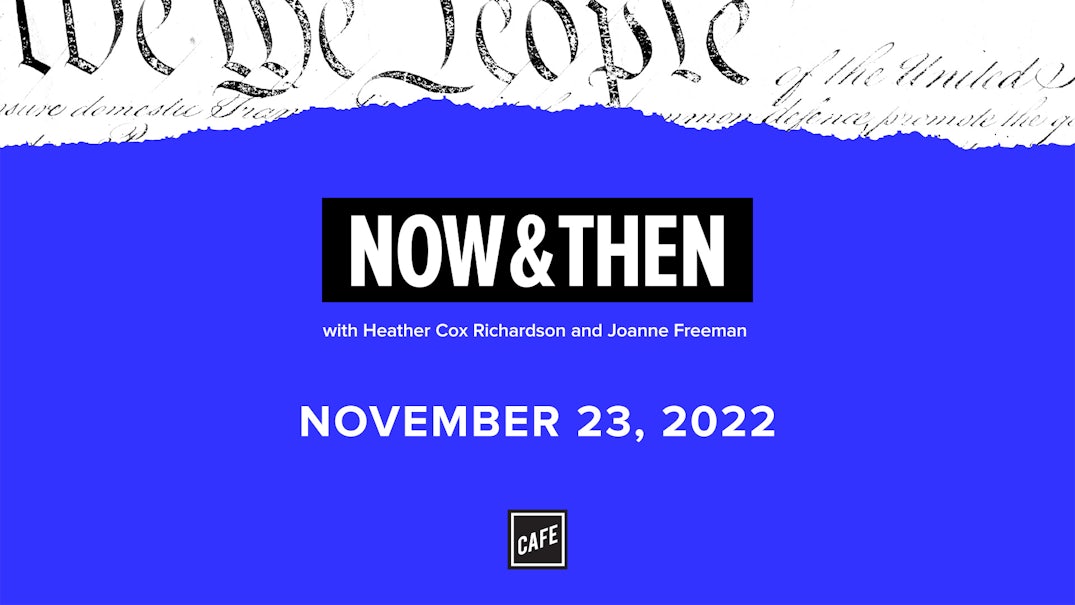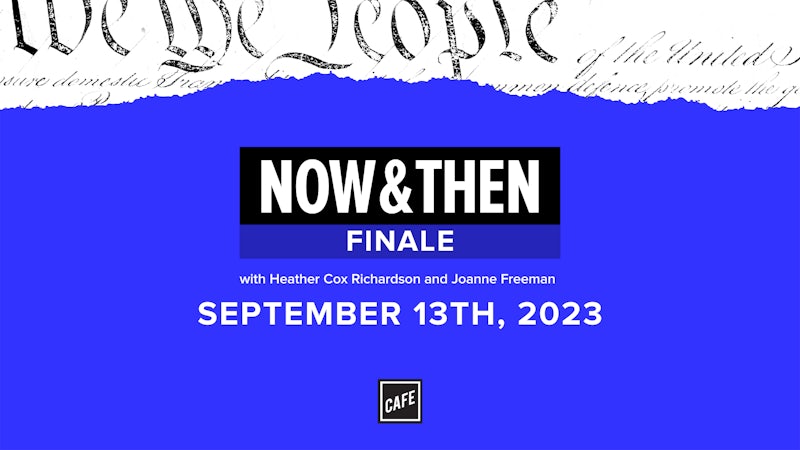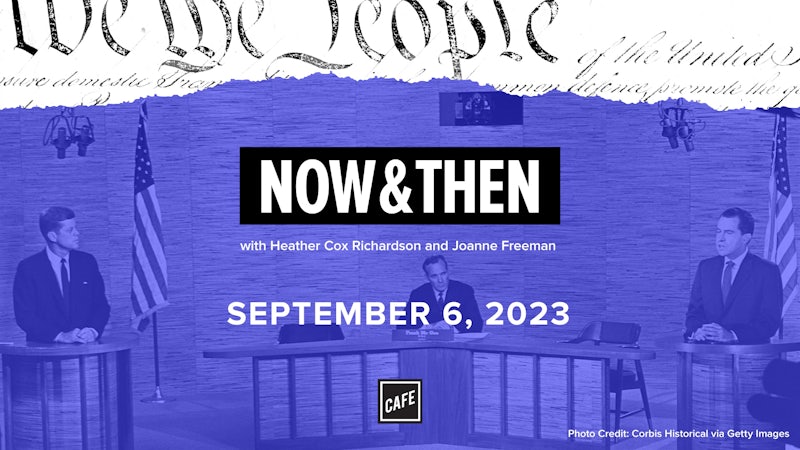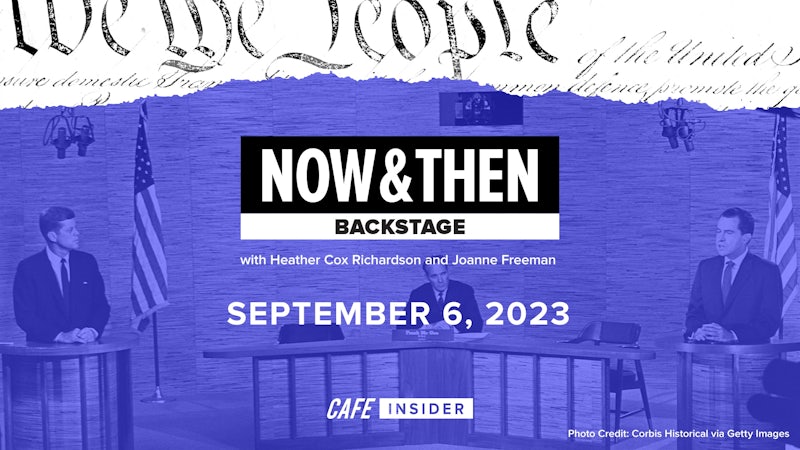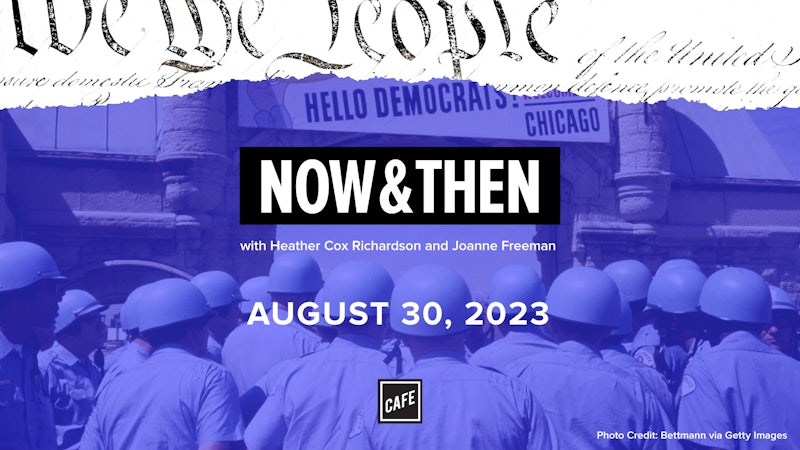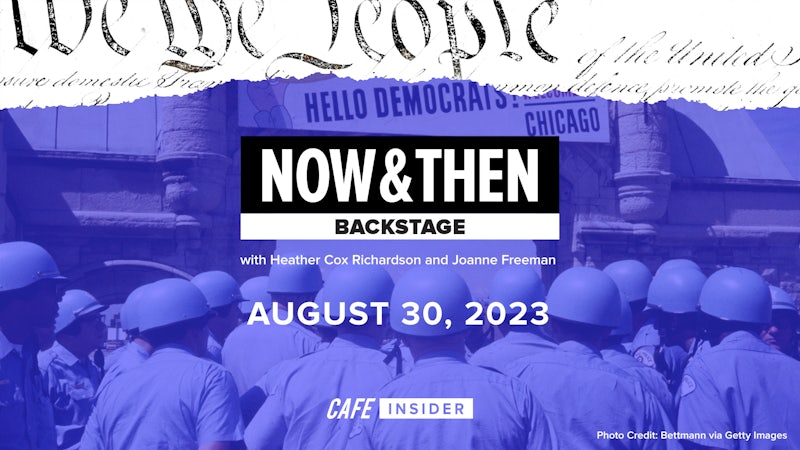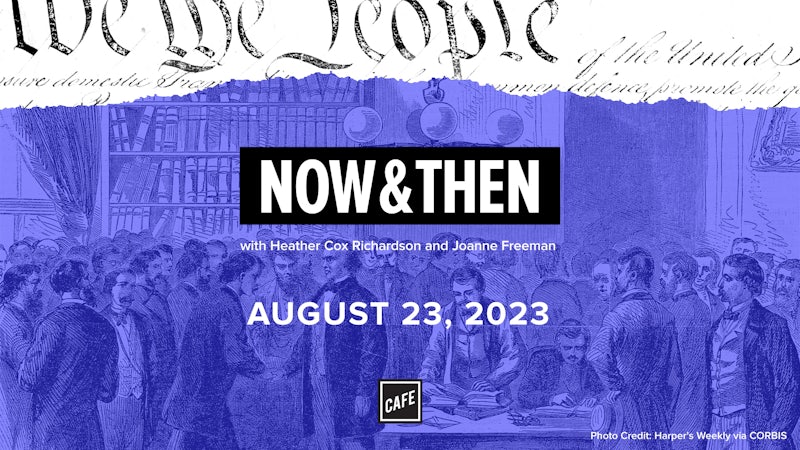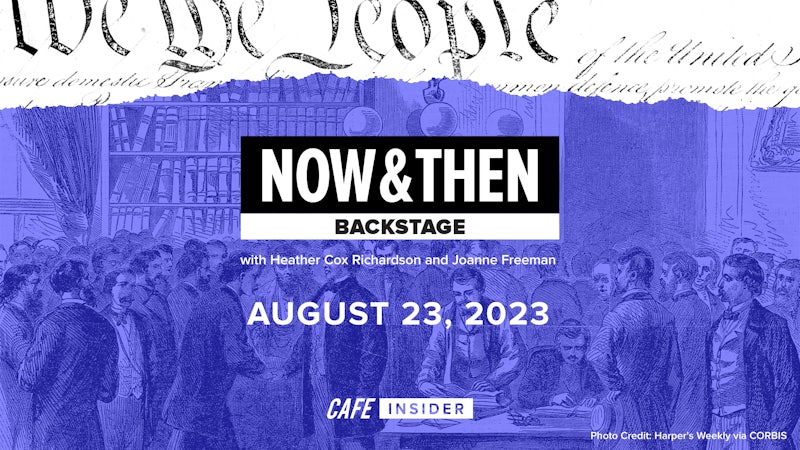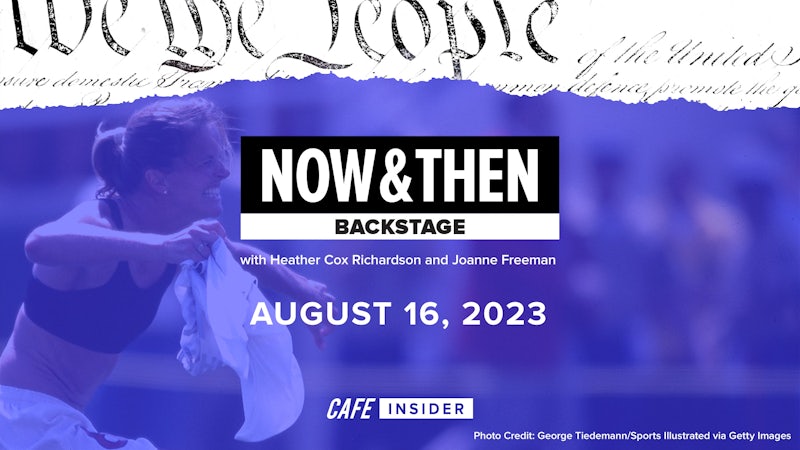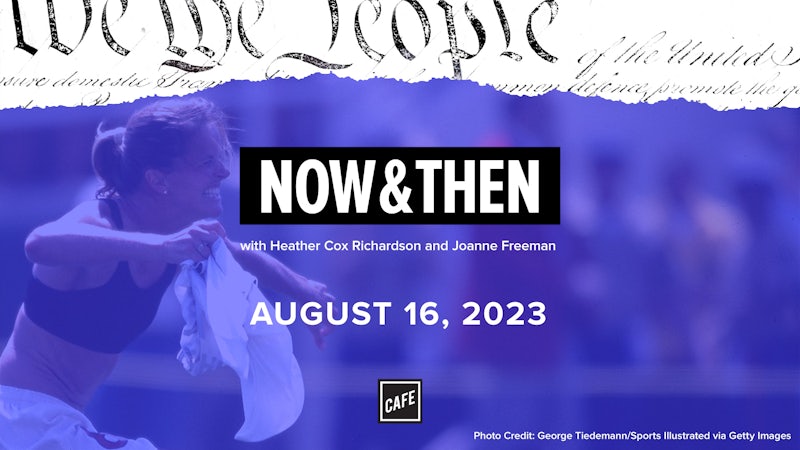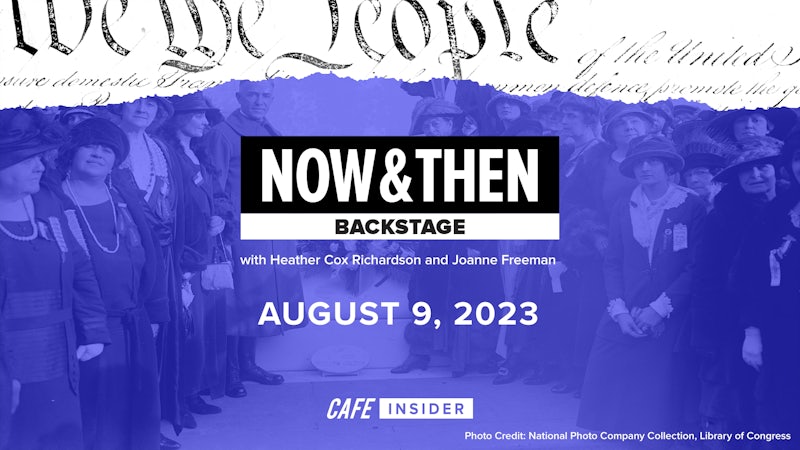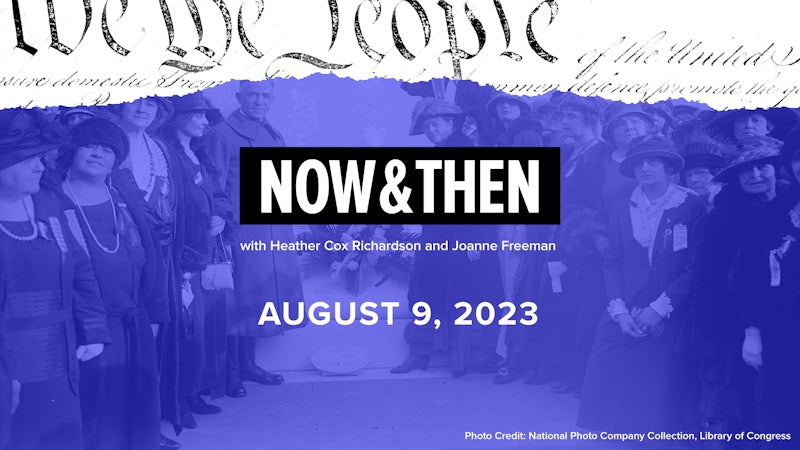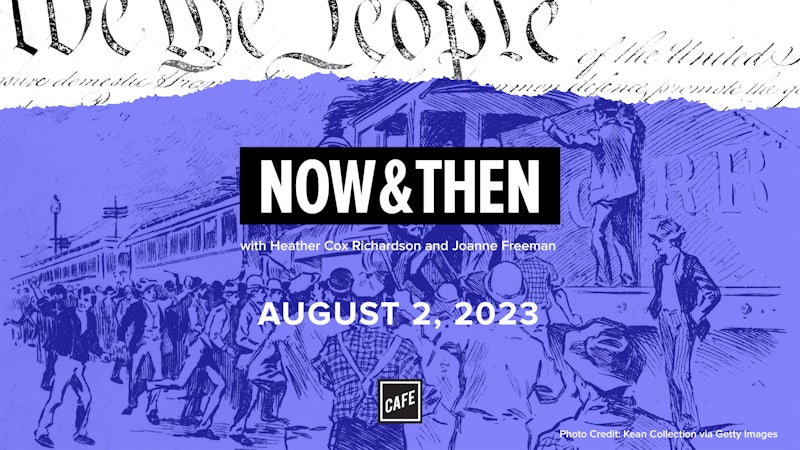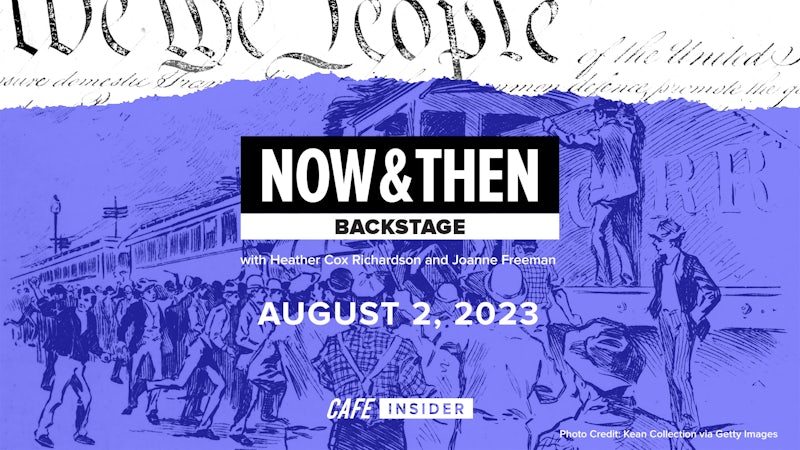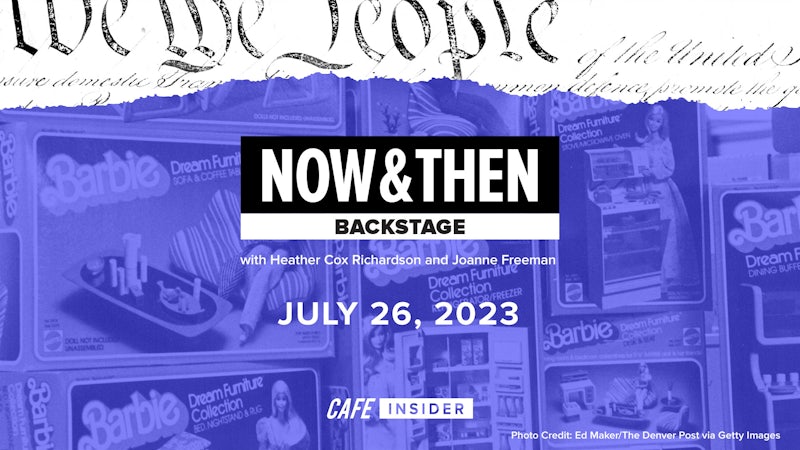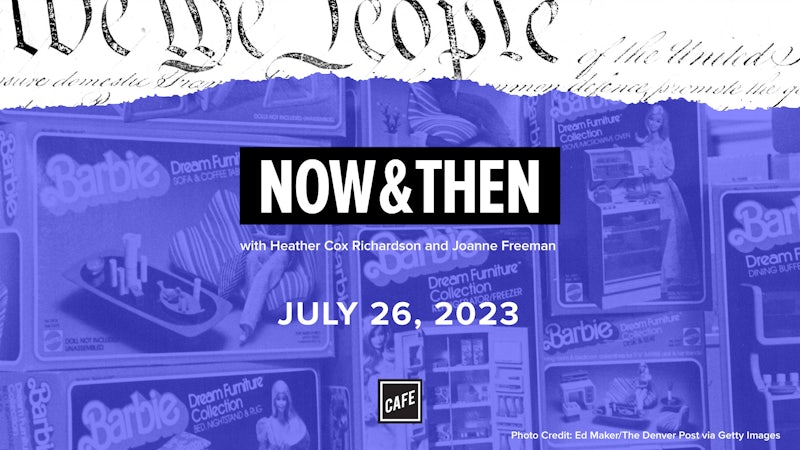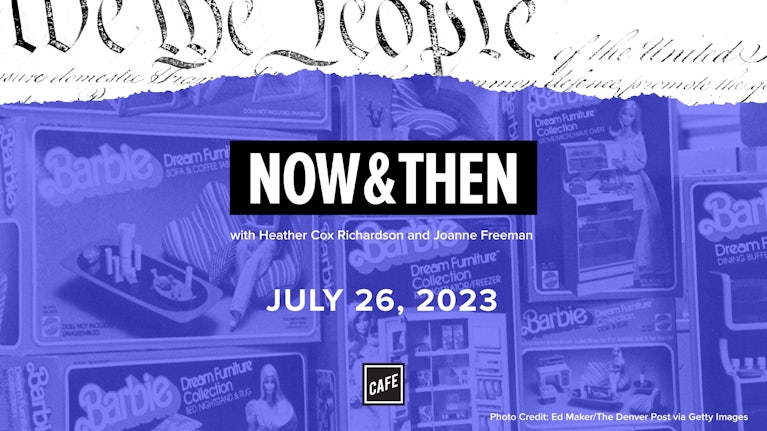Heather Cox Richardson :
From CAFE and the Vox Media Podcast Network, this is Now & Then. I’m Heather Cox Richardson .
Joanne Freeman:
And I’m Joanne Freeman. We’re doing something a little bit different on Now & Then this week. Last Thursday, we received the 2022 William Hickling Prescott Award for Excellence in Historical Writing. Presented in partnership between the Massachusetts Historical Society and the National Society of the Colonial Dames of America, Massachusetts.
Heather Cox Richardson :
We decided to make the award presentation at Massachusetts Historical Society into a live Now & Then episode taping. We highlighted five objects in the society’s collection that we thought shed light on ordinary Americans brushing up against major events in US history, commenting on them in their own ways to reveal a somewhat different story than we sometimes think of when we think about the collections in a historical society. We discussed voices as diverse as an intrepid cheese engineer, a group of imprisoned indigenous illustrators, and a defiant Harlem Renaissance sculptor.
Joanne Freeman:
In essence, Heather and I had the fun of going through the collections of mass historical online and figuring out what spoke to us, what objects spoke to us, not with the voices of very famous, all capital letters Americans, but rather really basically with one exception, ordinary Americans who in one or another way connected with a major historical event and left behind some account of it, some image of it, some kind of meeting moment with something that we very well recognize as being important parts of US history. So, we had fun picking the objects, as you’ll hear, we definitely had fun speaking about them. But in a way, what we were really talking about is making history in a different kind of way. Head to the link on the CAFE website at the top of this week’s show notes to see the objects that we picked and for other references and supplemental materials.
Heather Cox Richardson :
We hope you enjoy the conversation as much as we did.
Joanne Freeman:
Well, good evening to everyone. I want to give you just a little sense of what you’re going to be hearing tonight. I’ve already immediately forgotten how many million objects there are here.
Speaker X:
14.
Joanne Freeman:
14? Thank you very much. Okay.
Speaker X:
14 gazillion.
Joanne Freeman:
14 gazillion objects. So.t What we did in deciding what we wanted to speak about this evening is we decided we wanted to go through the treasures of the historical society, and we wanted to find a handful of objects that spoke to us in some way as historians. And what we particularly wanted to do… I’m guessing that for most people, you think about a historical society and you think about often great men, maybe some great women and letters from great men and great women. But what you’re going to see this evening is archives have amazing things in them that go beyond that. And this particular historical society has amazing, amazing artifacts.
And what we want to do is talk about these artifacts, all of which in one way or another, intersect with history, but they show you actual, real, normal, everyday people intersecting with history, commenting on it. People like you and me, who in one way or another, in some way express their feelings about a moment that pretty much for the most part, I think all of those moments or all of the ideas we’re going to be talking about are commonly known, but not in the way that we’re going to be talking tonight. Not through the eyes of average people who left behind a sign of themselves, sometimes, without necessarily even assuming that they were.
Heather Cox Richardson :
And who intersected, therefore, with really important events in American history, but in ways that they are not remembered for. So we had a wonderful time doing this. We actually spent many hours going through the collection, looking at things and things that we might want to talk about. And these are the things that we agreed on, but there were some honorable mentions that we may tell you about later.
Joanne Freeman:
That’s true. Now, this one in particular, this one was not hard for us to decide upon.
Heather Cox Richardson :
And we both knew the minute we saw it that we wanted to talk about it. It is a bottle that at least appears to be full of tea, tea leaves, and it says on it tea that was gathered up on the shore of Dorchester Neck on the morning after the destruction of the three cargoes at Boston, December 17th, 1773.
Joanne Freeman:
So, that is tea from what we now call the Boston Tea Party. Part of why that’s amazing is because the Boston Tea Party, which you must say in that tone of voice, is some big event that doesn’t really seem real, that actually wasn’t even called that necessarily at the time. It was a real event. It was a moment in which people here in Boston were upset. And the very quick and dirty version behind this is that there was the Tea Act of 1773 that was passed, and it was passed by the British government, largely because the East India Tea Company was having financial trouble. So, the idea was that they would lower import duties on East India tea, and that would inspire colonists to buy East India tea and not Dutch tea or other tea. And that somehow or other, this would help the East India company. And the British in the home country thought, “Well, this will be great. The colonists will be fine with this. We know we’ve been having a variety of different problems with taxes and such, but we’re lowering…”
Heather Cox Richardson :
We’re going to make tea cheaper.
Joanne Freeman:
Yeah.
Heather Cox Richardson :
We’re also going to undercut all the local tea sellers.
Joanne Freeman:
Now, Bostonians, and actually not just Bostonians, but colonists saw in this potentially an attempt somehow or rather to take over trade, to corral, to marshal what they had assumed to be free trade. They were upset by it. And throughout most ports in the colonies, tea ships came up to the ports and were kept out because the colonists were so upset at the idea of these ships unloading this tea, so a hugely controversial thing. The only place where the tea was not kept offshore was Boston.
Heather Cox Richardson :
And was Boston, in part, because of the political situation here.
Joanne Freeman:
Correct. That Governor Thomas Hutchinson decided this would be a fine place to unload the tea. It would be a way to really show that British were in power here and order was going to be restored. Everything was going to be fine-
Heather Cox Richardson :
And it went really, really well for him.
Joanne Freeman:
You do this every time.
Heather Cox Richardson :
We got it out of the way.
Joanne Freeman:
Anyone who listens to our podcast, she always does this, and it’s easier this time. I can tell you’re joking.
Heather Cox Richardson :
But you get still wind up.
Joanne Freeman:
I do always get very wind up. But so, I want to offer you a firsthand account of someone who heard what happened when it was announced that the tea was going to be unloaded at the harbor. And interestingly, this fellow was at home sipping tea when he heard the news. So, I’ll read you just a few lines of what he said. He said, “I heard such prodigious shouts that induced me while drinking tea at home to go out and know the cause of it. The meeting house was so crowded I could get no farther than the porch. You’d have thought that the inhabitants of the infernal regions had broke loose for my part. I went contentedly home and finished my tea, but was soon informed what was going forward, but still not crediting it without ocular demonstrations,” which I just love “Without seeing it for myself.”
Thank you, 18th century person, but without ocular demonstrations. So he goes and sees what took place, which is colonists who dressed as Native Americans, had hatchets, climbed aboard these ships, used the hatchets to break into these chest of tea and then threw them into the harbor. And what you see here is allegedly what was scooped up the day after the Boston Tea Party by someone in Dorchester Neck who knew what had happened, saw the tea, collected it, and kept it. Now, part of what fascinated us about that is here’s someone who knew, and it’s not a famous person, it’s a person who was wandering around, knew what had happened, and saw this, knew that that event had significance to it, knew that it had been a big deal, and scooped up and kept the tea to commemorate that. So, it’s an average person. I don’t know why this person, as you suggested, it’s December, it’s cold, this guy’s wandering around-
Heather Cox Richardson :
Dorchester Neck in December, but I love that they felt it was important enough to put in a bottle and then that people have saved it ever since because it’s an artifact of some dramatic change that they wanted to make sure they had a memento of. And you think about the times in your life that you’ve lived through where you’ve thought, “Oh, man, this is really important.” And you have thought somehow to make a memory of that. And then you realize it wasn’t that important after all, or you forget where you put it, or any number of those things. But here was someone who said, “Oh, boy, something really big happened last night, and I probably wasn’t a part of that, but I can keep this and I can pass this on.” And it mattered so much to everybody who came after that it’s here, and it is literally here in this building, and we could see it in 2022.
Joanne Freeman:
And this person, I don’t remember the age of this person, but was young. It was actually a young person, I want to say 13-
Heather Cox Richardson :
Well, we don’t really know who it is, do we?
Joanne Freeman:
We have a sense.
Heather Cox Richardson :
We have a lot of ideas.
Joanne Freeman:
We have a lot of ideas. I want to get down to the idea here so that we can get-
Heather Cox Richardson :
I like my idea.
Joanne Freeman:
Your idea is good, but it’s not that far off. It was a 5-year old boy named Thaddeus Harris, supposedly, who recovered this from the surf. Then there’s another story. Supposedly it was dumped out of someone’s boot. Here’s a person who, in one way or another, understood that in some way, something historic was happening, something significant was happening, he intersected with it, and saved it.
Heather Cox Richardson :
The next object we have chosen commemorated something incredibly unimportant for an incredibly unimportant president. So, we should maybe skip over altogether.
Joanne Freeman:
Now, if anyone here knows the podcast, Heather has issues with Thomas Jefferson. Oh, look.
Heather Cox Richardson :
So this is Thomas Jefferson reincarnated as a piece of wood.
Joanne Freeman:
You are already my favorite people right here. And Heather, you can attest to the fact that when we were looking around for objects, this came up and I became, so-
Heather Cox Richardson :
Okay, I wanted the tea. Let’s be honest.
Joanne Freeman:
She did.
Heather Cox Richardson :
This is her-
Joanne Freeman:
This comes up. And I’m like, oh, it’s the mammoth cheese. Okay, let me explain the mammoth cheese. And I’ve been saying to everyone, I’ve been talking about the mammoth cheese for about 30 years, and I laughed throughout it.
Heather Cox Richardson :
Okay. But just describe for people, this is not actually the mammoth cheese.
Joanne Freeman:
Correct.
Heather Cox Richardson :
Okay.
Joanne Freeman:
This is a piece of the mechanism that was used to make what came to be known as the mammoth cheese, which was a 1,200 pound wheel of cheese that was made for Thomas Jefferson after he became president, in honor of this man of the people, Thomas Jefferson, I think… Let me get it right-
Heather Cox Richardson :
Because every man of the people has a 1,400 pound piece of cheese.
Joanne Freeman:
I know. Well, and apparently it was known as… This just gets better from here folks, the greatest cheese in America for the greatest man in America. But the story behind this is really interesting. So, it was call the mammoth cheese because Jefferson, who always was trying to prove to people that everything in the United States was better, bigger, more wonderful than everything in the old world. He was always trying to prove that animals in particular were bigger here. It was proof that everything was better here. And he believed that there were woolly mammoth wandering around out in the frontier area of North America. So, the Federalists who did not like Thomas Jefferson, began referring to him as the mammoth president.
As often happens, the Republican said, “You know what? He is the mammoth president.” And people began to make mammoth food for Thomas Jefferson. There was a mammoth loaf of bread, a mammoth veal, a mammoth pipe, and a number of other ridiculous mammoth things that were given to Thomas Jefferson. But the most famous of all was the cheese. Now, the cheese was made in Cheshire, Massachusetts by several hundred farmers, their wives, and their daughters. And they apparently, as it was advertised at the time, used no federalist cows at all, only Republican cows. And John Leland, the reverend who organized this, of course, afterwards became known as the mammoth priest. So, this was put on a cart and taken to Washington, which is by this point where the government was. Someone at the time said, when it got to Baltimore, which was at least a month after it was made, it smelled strong enough to walk the remaining distance to Washington all by itself.
Now, Jefferson loved the mammoth cheese because it was a sign. It was of a moment when America felt, again, talking about a moment when something happened, the Federalists had been in power throughout the 1790s. They’re in a sense of a very aristocratic party. The election of 1800, Jefferson becomes president. And it feels to people like there’s been a sea change, the first transition of power, but also, now, we’re a country that appreciates democracy in a way that we didn’t before, and Jefferson symbolizes that, which is why somehow giving a cheese to the Democratic president seemed like the right thing to do. Jefferson loved it for that reason. And he would put pieces of it on his dinner table when he had guests. “There’s my cheese.” And apparently would offer people little pieces of it at various points years after he received it. And at one point I saw a diary entry from someone from Massachusetts who said, quote, “It was far from being very good.” But what I want to offer you before I explain, we explained together the reason, particularly why we picked this.
Heather Cox Richardson :
Wait, can’t you tell them what’s painted on the cheese?
Joanne Freeman:
Go ahead.
Heather Cox Richardson :
The cheese is painted red, and it has on it the motto, rebellion to tyrants is obedience to God.
Joanne Freeman:
This is a mammoth cheese. But so, the Jeffersonian Republicans and the Federalists wrote poetry about the cheese. And I just want to offer you a few lines just so you can get a taste for this. Okay. This is a Republican poem in honor of the mammoth cheese. “Most excellent, far famed and far fetched cheese! Superior far in smell, taste, weight and size. To any ever formed ‘neath foreign skies, And highly honored thou was made to please, the man beloved by all. But stop a trice, before he’s praised, I too must have a slice.” That’s the Republican poem. But my favorite of all is the Federalist poem, which is titled Reflections of Mr. Jefferson Over the Mammoth Cheese. “In this great cheese, I, Jefferson, see myself portrayed my life and fortunes in this useless mass. I curse the hands by which this thing was made, to them, a cheese, to me, a looking-glass.”
Heather Cox Richardson :
Okay. One of my ancestors totally wrote that.
Joanne Freeman:
This is wonderful, but the actual serious reason why we picked this is first of all, it does not look like a fancy thing of great importance. But this represents a bunch of people who came together to do something, men and women, and young folk as well, to do something that commemorated a political moment that was of importance for them, right? They made this massive cheese because it mattered. It was a reflection of a political moment that had meaning for them. So, for one thing, as quirky as this large wooden cylindrical object is, for those who might hear this on the podcast, it’s a quirky looking thing.
Heather Cox Richardson :
It is modified cider press. This is the screw from a modified cider press. And the full cider press was six feet in diameter, and the cheese was put inside a four foot hoop that was put inside the press. There was an engineer who was in charge of adapting the cider press to the mammoth cheese, and he went along with the cheese to present it to Thomas Jefferson.
Joanne Freeman:
He didn’t know you were going to get this much cheese. But I do-
Heather Cox Richardson :
He became very famous because of his ability to modify the cider press to make mammoth cheeses.
Joanne Freeman:
He did. But what’s significant is not only that these are normal Americans commemorating this, but when this was given, the cheese, not this, was given to Jefferson, he was told that this was made from Republican farmers, and wives, and daughters. When that statement was put in the newspapers, the wives and daughters were erased from it. They were gone. And so, that second reason why we wanted to talk about this is not only does it represent regular people, but it’s the erasure of regular people who just vanished from the making of it.
Heather Cox Richardson :
And yet, who had political voices in the sense that they participated in this stupid cheese.
Joanne Freeman:
It is not a stupid cheese, Heather, how dare you and insult the cheese.
Heather Cox Richardson :
But they were excited about participating in that, and having their cows and their work go into honoring the people’s president.
Joanne Freeman:
The next object was one that particularly Heather grabbed at and thought was interesting. So, why don’t you lead into this?
Heather Cox Richardson :
I love these images. This is a piece of ledger art, much of which was produced in Fort Marion in Florida, which I will tell you more about. But this is also something I suspect that many people would not have expected to see in the Mass Historical Society. It is an image done on paper in what was literally called a ledger book from the 19th century where business people would keep their records. And it is a series of paintings done by indigenous artists in the 1870s or 1880s. And they are depictions of a number of warriors on a buffalo hunt. So, there are one, two, three, four, five, six, seven, eight, nine, I believe, warriors that are riding their horses, and one whose horse is getting away, and he is trying to grab it, which I think is very important to actually. And then there are, around the edges of the ledger book, a number of bison, which are commonly known as buffalo, but they’re actually not buffalo. In America, they’re bison.
They are running as a herd and that are running off the edges of the page. And there is, to me, and I’ll talk more about this in a second, a really lyrical sense on this page of the freedom of being on horseback in a buffalo hunt. And there is this artistic sense where indigenous Americans, the women tended to produce patterns, which I find myself even more drawn to than these. The men tended to write their history on animal skins, and this gets translated to ledger art, but they tended to portray motion and action without it being cluttered up with things around it. So, you get literally hear the objects on blank space creating I think a very fine sense of movement.
Joanne Freeman:
The people who were creating these ledger books had actually been captured and were imprisoned. They were all Native Americans who were warriors. And part of what they had been fighting about was over buffalo or bison that hunters had been basically capturing, and they were depriving these people of something that was vital to them for food. So, it shows these animals running off the page as something actually rather touching about that, since part of what they’re commemorating here is something that they were being deprived of in one way or another.
Heather Cox Richardson :
So, the bison are being depleted by then. What happens is in June of 1874, there is a big battle that you’ve probably heard about. It’s the Second Battle of Adobe Walls. And I say, you’ve probably heard about it because if Lonesome Dove in the scene where Lorena and Gus are in a broken down, old building, and he says, “There was a big fight here a while back.” He’s referring to the Second Battle of Adobe Walls in that. And that second battle started a series of battles on the planes that ends up putting a number of the indigenous people who fight them into prison into the local fort. And at that fort, they realized they can’t hold all the warriors that they’re collecting from the Plains Wars, the Comanche, the Kiowas, the Southern Cheyenne, and the Arapahos. And so, somebody gets the idea that the way to handle these indigenous warriors and their families is to send them to Fort Marion, which is now in St. Augustine, Florida. And they send them to that prison.
And if you have been to it, which I highly recommend doing, it’s really astonishing because it’s a fort that’s made of rock and it’s really cramped. It’s a very small feeling, and the rooms are dark. There aren’t windows, it’s a fort. They’re very dark, very small. And they corral these indigenous Americans into this hot St. Augustine, Florida, muggy place, after being on the planes. Originally, they put them in chains and then they get a new superintendent, a man named Richard Pratt, who says, “Well, maybe we can figure out a way to incorporate or assimilate these indigenous people into American society.”
So, he takes off their chains and he tries to get them to assimilate into American society in a really tricky way. And that is to make them essentially assimilate through being in the military. And what’s interesting about that is this is the 1870s, right? And Pratt is himself, a military officer, but if you’re a military officer after the Civil War, there’s not a lot of work for you unless you’re going to go out into the West and there isn’t even a lot of work there. So, somebody like Pratt kind of needs to find a job to find a point on it. And he kind of invents a job for himself, turning indigenous Americans into good little soldiers. I hope you know where this is going.
Joanne Freeman:
So as one would expect, he cuts the hair of all these people, he puts them in military uniforms, and he gives them these ledger books, and colored pencils, and a variety of other things, and basically tells them, asks them to draw images of what their experiences are, of what their memories are. And ultimately, some of these images and ledger books were given to guests. Some of them were sold and given to tourists of various sorts. But the idea, in one way or another, and Pratt I think, saw this as part of getting these native Americans, these warriors, to sort of spill who they were on this piece of paper and sort of move on to something different. Pratt said a little bit later in his life, when he was talking about his view towards Native Americans, it was a speech that he gave actually in 1892 titled The Advantages of Mingling Indians with Whites, and it had a line in it that said this quote, “Kill the Indian in him and save the man.”
Heather Cox Richardson :
So by starting the indigenous Americans at Fort Marion on the process of creating something they could sell, he is doing that version of assimilation. And what’s great about the ledger art is that this is actually a very particular one in that it’s so deliberately shows life as part of a buffalo hunt. And again, a sense of humor up here with this guy who’s fallen off his horse. But a lot of them are really fascinating because they’re grappling with railroads, they’re grappling with the changing scenery-
Joanne Freeman:
The fort itself.
Heather Cox Richardson :
… and they are images of this attempt of a group of people to find their own way through this moment of assimilation. And the reason that I mentioned that he is trying to turn indigenous warriors into good little military people is because I hope some of you recognized his name as the man who’s going to start Carlisle Indian School. Because what he figures out is that if this system works with the adult indigenous warriors, it should work all the better with children. So, by 1878, a lot of these artists and the people who were imprisoned at Fort Marion have been allowed to go back to the reservation where theoretically, they now have a base to support themselves, except they don’t have access to ledger books, or paints, or colored pencils, or colored ink, or customers.
So, a lot of the artists never continue in their work, but he goes ahead and he figures out that according to the treaties that the US government coined with the indigenous Americans, the government agrees to provide schools for the indigenous children, but it doesn’t say where, little loophole there. And that was not something when they wrote the treaties that they were thinking about. Everyone assumed that the schools would be on the reservations. But Pratt says, “No, no, no, no. We’ll put them in used army barracks. And here’s some right here in Carlisle, Pennsylvania.” And that’s how we get the Carlisle Pennsylvania Indian Schools where the kids are treated like little military people. They’re supposed to live by a military system of rules. They have their hair cut, they have the uniforms, they have the whole thing.
Joanne Freeman:
It’s worth saying too, that some of these ledger books were given to people to raise money for what becomes the Carlisle School. Part of our theme that we’re talking about tonight is ordinary people sort of intersecting with these moments of historical import. It has to do with the artist Bear’s Heart, who apparently was 24 years old at the time. And as I suggested earlier, it’s not like this is an entirely voluntary thing that they were doing, but what I find myself thinking about is the people, Bear’s Heart and others… I think there’s another man named Making Medicine who also did some of the drawings. They knew that they were making these drawings for a white audience, for Pratt, for guests, for tourists. And it really made me want to go and actually look at the drawings and try and see them through that lens. You could see, again, someone expressing himself in a way that could be invisible unless you know the story behind the artifact.
Heather Cox Richardson :
And just a little bit more on the schools. You all know those schools because one of the ways that Pratt hoped to make the Indian Boys assimilate was by getting rid of their warrior tendencies in fairly contained ways, like say, football. And one of the ways to get them to play football well is to get a decent coach like say Pop Warner. And that’s where we get Pop Warner football from. But this particular piece of ledger art is also interesting because the reason it’s here is because one of the people who was interested in this experiment that Joanna is talking about was himself a writer of American history about the American West, and believed that the world was really in a conflict between democracy and monarchy between all these binaries and the places where that played out was in the American West, he believed, during the American natural world, and that was Francis Parkman. So, Francis Parkman acquired this book that once again, we now have, here in this building, of a number of indigenous Americans who were trying to make their way through this incredibly fraught political moment.
Joanne Freeman:
And it was obtained. Parkman himself was part of the school of thought that believed that the conquest of Native Americans was the victory of civilization over savagery. This piece of art is framed in so much history that’s unfolding with these people literally imprisoned in the middle of it. So, it’s an incredibly powerful piece of art. And again, we’re looking at someone testify to their experience of being in the middle of this historic moment. So, the next object here that struck us in this case, the letter is by Meta Warwick Fuller, who is not an unknown person. She actually was an African American artist. She was part of the Harlem Renaissance. It is a letter from Meta Warwick Fuller to a friend of hers, Marion Colvin Deane from Framingham, Massachusetts, from January 5, 1928.
And as you’ll hear in a moment, it describes something that she saw in the course of an average day. She was this famed African American artist. She used Afrocentric themes. She was a sculptor, she was a theater designer, she was a poet, she was a painter. And this letter is written to Marion Colvin Deane, who was a white Canadian woman who worked at the Hampden Institute.
Heather Cox Richardson :
Yeah, she is on a bus in Framingham, Massachusetts, and she overhears a woman talking.
Joanne Freeman:
She says, “I was on the way home after a few errands downtown and laden with the usual packages, bundles, and such. I was taking the bus and while fishing for my ticket, I noticed a youngish sort of woman talking about traveling. Contrary to custom, having succeeded in finding my ticket, I took a seat at the extreme end of the bus, it being filled up in the front. I could still hear the conversation. She spoke of how strange it seemed to see colored people mingling with white people in schools, and restaurants, and the like. She would go out if one sat down at a table with her, it didn’t seem right. It all impressed me as very funny, and mischief got the better of me. I wrote on a slip of paper, ‘God made man of one flesh.’ I rolled it up and as I passed on my way out, I dropped it in her lap. I was convulsed at the expression of surprise when she saw what I had done, but I left the car before she had time to read it. I have not since seen the woman with whom she was talking, but I am curious to know what she did after reading it.”
That’s a remarkable moment. Again, it’s a woman who is known. Actually her mentor was Rodin, Auguste Rodin was famed sculptor. But what’s wonderful about this letter is it tells about her being on a bus, overhearing a conversation, describing the impact it had on her, and the little thing that she did that gave her some satisfaction in that moment. Again, it’s showing you this moment in time, and I believe that at this point, she and her husband, there were not a lot of Black Americans in Framingham, Massachusetts at the time, so this is partly describing her experience. But she’s offering you a sort of daily story, a little anecdote, about running errands and what she overheard. How much more powerful can it be for you to get a sense of what it felt like to be this person in this place at this time than for someone to stash off a letter to a friend and offer that kind of first person testimony to it?
Heather Cox Richardson :
And first person testimony that’s got a sense of humor in it. Again, the idea that when you think about the 1920s in America… 1928, this letter is from, January. I know I’m doing the whole cold New England thing here, but it is after all November and the temperature dropped about a gazillion degrees in the last week. You don’t think about a very talented Black artist in a Boston, Framingham, Massachusetts writing a note to the nasty white lady in front of her and saying-
Joanne Freeman:
Talking loudly enough that she can hear it across the entire bus.
Heather Cox Richardson :
Oh, she must have meant to be heard and was clearly sort of throwing it back in this lady’s direction. And she didn’t start a fight. She didn’t do any of the things that would’ve shown up in the newspapers, would’ve shown up in the textbooks. Instead, she passes the woman a note.
Joanne Freeman:
She said she could use the word mischief. What’s wonderful about that is she has this moment, she hears this conversation, and her response is like, “Here you go.”
Heather Cox Richardson :
Haven’t we all been there, where you wanted to do it, but you didn’t? And she did.
Joanne Freeman:
She did it. And then, she wrote it down, which is why we’re here talking about this.
Heather Cox Richardson :
And that’s one of the beauties of collections like we have here. We have not just those documents here, we have this vision of what life was like in that moment in Framingham, Massachusetts, in the 1920s, at a time when lynching is of course, at a very high rate. And members of both political parties, the leadership of both political parties have turned against the idea of Black rights. And she is taking her own stand in her own quiet way. And I think, giving a really rounded picture-
Joanne Freeman:
Rounded and powerful.
Heather Cox Richardson :
… picture of what avenues might or might not have been open to a woman who is obviously a woman of extraordinary brains, and talent,, and probably money if she’s on in Warren Street in Framingham in ’28, and the little that she can do or feels powerful enough to do in that moment. It’s a lovely, lovely letter.
Joanne Freeman:
And we did spend several hours playing around with things when we were trying to decide what to do.
Heather Cox Richardson :
We spent much too long.
Joanne Freeman:
We do. Which we didn’t realize till the end. And that it was like, “Uh, oh.”
Heather Cox Richardson :
You are not going to see the silver hotdog.” And you think I’m kidding, and I’m not.
Joanne Freeman:
No, there was a silver hotdog. We talked about it, but you’re not going to see it. Okay, we have one more object we want to talk about.
Heather Cox Richardson :
And this is a watercolor image of a Japanese internment camp. The reason that this really jumped out, at least at me, from the first moment I saw it, is there is a street with huts on either side of it, lined up with telegraph wires across the top of them, a building to the left that has smoke stacks with smoke coming out of them, and the smoke is mingling with blue and yellow clouds. And in the back there is a looming mountain that looms over the entire scene. But then, absolutely magically, there are three kites dancing above the structures. And I think this image is one of the more spectacular images I’ve ever seen. And one of the things when we do history, people think we look at papers and newspapers, and we certainly do those things, but all the objects we’ve been talking about, except the previous letter, are objects that are not ones that people necessarily look at and think about when they think about interrogating when they’re taking a look at history. But this is a watercolor done from a Japanese internment camp.
Joanne Freeman:
So, Estelle Ishigo was an artist and was studying art at the Otis Institute of Art, worked in watercolors, also actually worked in charcoal and drawing. So, this wasn’t the only medium that she worked in. She met an American Japanese man at the institute. They drove to Mexico so that they could avoid American anti-miscegenation laws. They got married, she was disowned by her family. And then we move into the era of World War II and Pearl Harbor, and they both end up being fired from their jobs. Her husband, because he is a Japanese American, she, because of her last name.
Heather Cox Richardson :
So, just to be clear, what were called anti-miscegenation laws in the American West literally had tables of which races could marry which, and the Japanese American, Euro American mixture was illegal. So, they go to Mexico and they come back and all they go through all that, Pearl Harbor happens, and then on February 19, 1942, the president, Franklin Delano Roosevelt, issues the Executive Order 9066, which gives General John DeWitt, who is responsible for the defense of the West Coast Authority, to order the mass evacuation of issei and nisei from the West Coast and from other military areas. It doesn’t actually involve the entire US, it’s the Western theater, with the idea that nobody quite knows if those people are going to be loyal or if there might be another attack from the air, coming from the Pacific. Beginning in March of 1942, they relocate 120,000 people, including 70,000 American citizens to 10 relocation camps across the West.
Joanne Freeman:
So, ultimately, Estelle Ishigo and Arthur Ishigo get relocated to Heart Mountain relocation camp in Wyoming. What it says, you probably can’t read it, but what it says in the corner here is, “Mess Hall, Bathroom, Barracks, Japanese Relocation Center, Heart Mt. Wyoming.” Now, apparently the government recruited her to be a kind of documentary reporter for the war relocation authority, and so she was actually asked to make drawings, which this kind of makes me think back to that ledger book, where she’s asked to depict what it is that she’s seeing. Now, what’s interesting is, and I found this after we had found the object and decided we wanted to talk about it, this is her actually talking about her experience there and what she chose to use to draw while she was there.
She said, “Strange as it may sound, in this desperate and lonely place, I felt accepted for the first time in my life. The government had declared me a Japanese and I no longer saw myself as white. I was a Japanese American. My fellow Heart Mountain residents took me in as one of their own.” So, on the one hand, that’s a positive expression. On the other hand, this was a cold, dismal place and she describes it very much, that mountain sort of looming over everything. But interestingly, more often than not, she used charcoal sketches and pencil drawings when she did her artwork there because she found that watercolors were, quote, “too clean and untroubled” to capture the experiences of the camp.
So, what’s remarkable about this is the precise thing that you grabbed at when we first looked at it, which is this is a watercolor, and what it does capture is something flying above, floating above the scene with the mountain looming and these barracks in the foreground, the watercolor makes sense in this context. She’s testifying to something of the spirit that she sees here that isn’t just the unpleasantness of the camp, it’s a spirit, her spirit, that she’s getting from being in this place, from the people who are there, more than anything else.
Heather Cox Richardson :
Well, she said of her time in the internment camp, of the mountain, “Gathered close into ourselves and imprisoned at the foot of the mountain as it towered in silence over the barren waste. We searched its gaunt face for the mysteries of our destiny.” And to me, the use of those kites, a child’s symbol, flying over the mountain is just so incredibly powerful and such a very powerful statement of, once again, a name that many people may not have heard of leaving her mark on this incredibly important moment in American history and in American political history in a way that is ever so much more powerful than so many of those memos that say, yes, this is how we’re going to proceed next. This one really jumps out of it.
Joanne Freeman:
It’s moving, and it really does depict the power and the impressment of being the camp and the freedom that hovered there for her.
Heather Cox Richardson :
If only you could get above it.
Joanne Freeman:
Exactly.
Heather Cox Richardson :
Exactly. So, we were deliberately trying to set tonight the story of individuals who weren’t necessarily marked in history and who were often marginalized, but who left a record that we can read and interpret to understand our history.
Joanne Freeman:
We do tend to think of history as the Boston Tea Party and the great men doing the thing that great men do. But the fact of the matter is that of course, it almost doesn’t need to be said. History is us. History is people. History is people living their lives and making choices. And I think particularly, in the moment that we’re in and we are living through historic times of our own. In this moment, I think it’s an important thing to recall the importance, our importance in this moment of what we see, and what we witness, and what we save, and what we choose to record, and what we decide to pass on to people after us as we capture what it feels like to be here in this moment, and how we in doing so will create history and pass that on to another generation.
Heather Cox Richardson :
Thank you for being here.
Joanne Freeman:
Thank you.
Heather Cox Richardson :
Thanks so much for listening to this live episode of Now & Then. And thank you to all the folks at the Massachusetts Historical Society and the National Society of the Colonial Dames of America, Massachusetts, for the award and for making all of this possible.
Joanne Freeman:
From Heather, me, and the entire Now & Then team, we wish you a wonderful Thanksgiving.

















